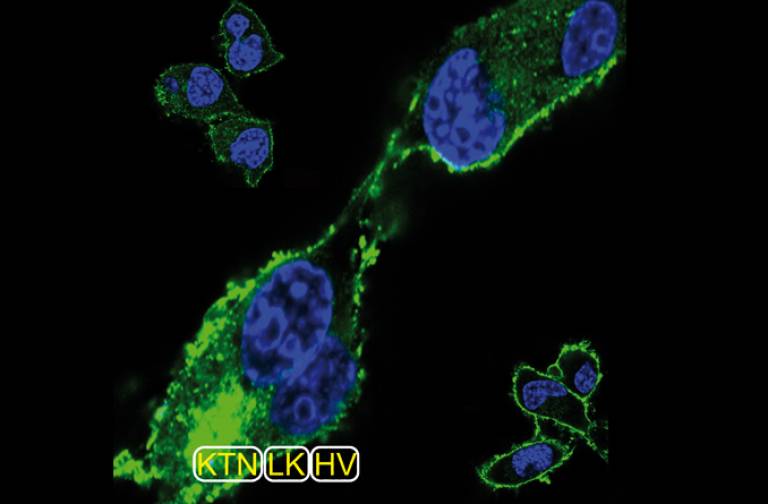Decoding Building Blocks of the Prion Protein essential for Prion Propagation: Easy as Lego
3 July 2023

Production of abnormally shaped proteins in the brain causes incurable brain diseases such as prion diseases. Normal cellular prion protein is made by most cells in our body, including brain cells, but it can change shape upon contact with abnormally folded prion protein (called a prion, see the link here to find out more about prions). Cells that do not make prion protein are completely resistant to prion infection.
Prions are unique pathogens because they can spread between humans and other animals but consist only of proteins, and like any other protein, they are composed of a chain of Lego-like bricks called amino acids. The amino acids in different parts of the prion protein determine the shape and form of prions, and depending on their location in the prion protein molecule, they can also affect the ability of the prions to infect mammalian cells. Savroop Bharma and Parineeta Arora at the MRC Prion Unit at UCL and Institute of Prion Diseases undertook experiments to determine which amino acids are essential for the efficient propagation of prions. Once we know this, we may be able to decipher which parts of the prion protein are particularly vulnerable to changes, which may help us target treatments.
Savroop Bhamra (while a PhD student) and Parineeta Arora, MRC Senior Research Technician and joint first authors said:
“We used a well-established molecular biology technique called mutagenesis. First, we made cells that didn't have much of the prion protein, so they couldn't get infected by prions. Then, we added back different versions of the prion protein, where we changed one, two, or three amino acids at a time to the amino acid called alanine. We decided not to change the two amino acids, proline and glycine, because they help to maintain the structure of the protein. Then we tested these different versions (mutants) of the prion protein to see if they could support infection with four biologically diverse strains of prions called Rocky Mountain Laboratory (RML), ME7, 22L and MRC2. This would enable us to identify which parts of the prion protein are important for prion propagation.”
“We found that a group of amino acids in a disordered region of the prion protein, specifically amino acids 105 to 111, were necessary for propagation of all four prion strains. Other amino acids didn't have an effect or only affected specific strains. When we replaced these critical amino acids, leucine 108 and valine 111, or the cluster of lysine 105, threonine 106, and asparagine 107, prion propagation was severely inhibited.”
“Taking advantage of the recently deciphered near-atomic structure of prion fibrils, we then asked if these amino acids could also be involved in formation of stable infectious prion fibrils. Collaborating with Szymon Manka, a senior scientist at IoPD, we discovered that our five amino-acid “Lego bricks” important for propagation were also needed for arranging the disordered region of the prion protein into ordered structures found in infectious prion fibrils from two mouse prion strains, namely, RML and ME7.”
Szymon Manka, senior scientist involved in the study said:
“When comparing the structure of cellular PrP with that of prion fibrils purified from infected mouse brains, it became apparent that a part of the prion protein called the Charge Cluster 2 (CC2), which is disordered in cellular PrP, becomes ordered in the fibrils. It forms a major positively-charged patch on their surface. The patch is stabilised by a structural arrangement known as the beta-sheet, in which one chain of “Lego blocks” binds side-to-side to a neighbouring chain. This arrangement enables fibril formation (propagation), hence prion fibrils (like all other so-called amyloid fibrils) are particularly rich in it. The five amino acids identified by Savroop and Parineeta as critical for prion propagation (lysine 105, threonine 106, asparagine 107, leucine 108 and valine 111) all turn out to be located around one of the first beta-sheets along the chain. This particular beta-sheet is shared among all prion fibril structures identified to date, and apparently, its formation is critical for the whole assembly, to efficiently recruit new chains and keep growing.”
Parmjit Jat, senior scientist who led the study said:
“Overall, our findings suggest that specific amino acids important for prion propagation promote the ordered structure of the CC2 region within prion fibrils. In the future, we will investigate whether the cluster of three amino acids (105-107) alone is enough to bind infectious prions and initiate propagation, or if other factors are involved in this process.”
This work was featured on the cover of the JMB issue
 Close
Close

